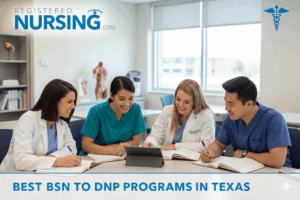APRN Consensus Model: What Nurses Need to Know
- Why the APRN Consensus Model Matters
- Origin and Development of the Model
- Four APRN Roles Defined
- Components of the Consensus Model
- Benefits of the Consensus Model
- Current Implementation Across States
- APRN Consensus Model and the Future of Practice
- Practical Implications for Aspiring APRNs
- Sources
- Latest Articles & Guides

The Advanced Practice Registered Nurse (APRN) Consensus Model is a regulatory framework designed to standardize how APRNs are educated, licensed, certified, and allowed to practice across the United States. Developed to reduce variability and confusion in APRN roles from state to state, this model supports consistent, high-quality patient care by ensuring that advanced nursing practice is defined by clear, national standards.
According to the National Council of State Boards of Nursing (NCSBN), inconsistencies in APRN practice across states have historically led to barriers in mobility and care delivery. As healthcare systems increasingly rely on APRNs to expand access, the need for uniform practice regulations is more pressing than ever. The Consensus Model offers a solution aimed at regulatory alignment, clarity in role definition, and broader provider access.
Although adopted to varying degrees across the country, the Consensus Model continues to shape legislation, licensure requirements, and scope of practice regulations. For current and aspiring APRNs, understanding this model is essential for navigating the evolving professional landscape.
Why the APRN Consensus Model Matters
Before the introduction of the Consensus Model, APRN practice was regulated inconsistently across the United States. A Nurse Practitioner in one state may have full practice authority, while the same NP in another state may require physician supervision. This fragmentation limited practice mobility, created public confusion, and complicated employer credentialing.
The APRN Consensus Model addresses these discrepancies by outlining a standardized set of guidelines. These standards improve role clarity, support interprofessional collaboration, and enable license portability—all of which are critical in a healthcare system shaped by workforce shortages, telehealth growth, and demand for team-based care.
Origin and Development of the Model
The Consensus Model was published in 2008 by the APRN Joint Dialogue Group, a collaboration of major nursing organizations including the National Council of State Boards of Nursing (NCSBN), American Association of Colleges of Nursing (AACN), and American Nurses Association (ANA).
This coalition aimed to unify APRN regulations under a single framework to eliminate confusion and enhance professional mobility. The model sets forth recommendations for how states should license, accredit, certify, and educate APRNs. It does not override state authority but provides a template for consistency.
Four APRN Roles Defined
The Consensus Model identifies four recognized APRN roles. Each role requires graduate-level preparation and national certification. Understanding these roles is essential for educational planning and credentialing.
| APRN Role | Description |
| Nurse Practitioner (NP) | Delivers primary, acute, and specialty care. Often serves as a primary care provider. |
| Clinical Nurse Specialist (CNS) | Provides expert consultation in clinical settings and improves system-level patient outcomes. |
| Certified Nurse Midwife (CNM) | Manages reproductive health and childbirth for women and newborns. |
| Certified Registered Nurse Anesthetist (CRNA) | Administers anesthesia and manages pain before, during, and after surgical procedures. |
Each role is aligned with one or more of six population foci: Family/Individual Across the Lifespan, Adult-Gerontology, Pediatrics, Neonatal, Women's Health/Gender-Related, and Psychiatric/Mental Health.
Components of the Consensus Model
The model is anchored in the LACE framework: Licensure, Accreditation, Certification, and Education. These elements work in concert to establish a cohesive standard of advanced nursing practice across states.
Licensure
Licensure must reflect the APRN's role and population focus. States are encouraged to issue a single APRN license, separate from the RN license, clearly indicating the practitioner's specialization.
Accreditation
Graduate nursing programs must be accredited by recognized accrediting agencies. Accreditation ensures that curricula meet established educational standards and prepare graduates for advanced clinical roles. The AACN provides oversight and guidance on program standards.
Certification
National certification verifies competency in a specific APRN role and population focus. Certification exams are administered by credentialing organizations such as the American Association of Nurse Practitioners (AANP) and others, depending on the specialty.
Education
APRNs must complete graduate-level education, either a master’s or doctoral degree, that is aligned with their intended role and population. Programs include didactic instruction and extensive clinical hours.
Benefits of the Consensus Model
The APRN Consensus Model promotes consistency, quality, and flexibility in advanced nursing practice. It benefits healthcare providers, institutions, and patients in several ways:
- Portability of licensure: APRNs can more easily move between states that adopt the model.
- Clear role definition: Employers and patients can better understand APRN responsibilities.
- Foundation for full practice authority: Standardized training and certification support efforts to expand APRN autonomy.
- Greater workforce adaptability: The model supports deployment of APRNs where they are most needed, especially in rural or underserved areas.
Current Implementation Across States
Despite widespread support from national organizations, state-level adoption of the Consensus Model has been uneven. Some states have fully implemented the LACE framework, while others retain outdated licensure or restrictive practice laws.
| Implementation Status | Description |
| Full | State licenses APRNs by role and population focus and uses all LACE elements. |
| Partial | State incorporates some LACE components but retains restrictions on autonomy or outdated licensure formats. |
| Limited | State has not adopted the model or has significant regulatory barriers. |
Real-world example: An APRN licensed in a full-implementation state like Oregon may practice independently and hold a license specific to role and focus. In contrast, an APRN in a limited-adoption state may need collaborative agreements and face limitations on prescriptive authority.
For a broader overview of multistate RN licensing, see the NLC and RN license transfer guide.
APRN Consensus Model and the Future of Practice
The Consensus Model plays a central role in ongoing reforms aimed at modernizing the healthcare workforce. As of 2025, national initiatives, such as the APRN Compact and telehealth expansion, rely on consistent role recognition and standardized licensure.
Efforts to remove practice barriers and expand full practice authority are supported by evidence linking APRN-led care to improved patient outcomes. The Consensus Model reinforces these efforts by ensuring that education, certification, and licensure are aligned across roles and states. Organizations like the American Psychiatric Nurses Association (APNA) continue to advocate for full implementation.
Practical Implications for Aspiring APRNs
For those planning a future in advanced nursing, the Consensus Model offers clear guidance:
- Choose an accredited program that prepares students in alignment with one of the four APRN roles and six population foci.
- Understand certification requirements for the chosen specialty and ensure eligibility upon graduation.
- Review licensure laws in states of interest, especially for those considering relocation or telehealth practice.
- Support advocacy efforts to advance full practice authority and model-aligned licensure reform.
Aligning with the Consensus Model improves readiness, mobility, and professional recognition while enhancing the overall quality of care.
Sources
- National Council of State Boards of Nursing (NCSBN) – APRN Consensus Model
- American Association of Colleges of Nursing (AACN)
- American Nurses Association (ANA)
- American Association of Nurse Practitioners (AANP)
- American Psychiatric Nurses Association (APNA)
Latest Articles & Guides
One of the keys to success as a registered nurse is embracing lifelong learning. Our articles and guides address hot topics and current events in nursing, from education to career mobility and beyond. No matter where you are on your nursing journey, there’s an article to help you build your knowledge base.
Browse our latest articles, curated specifically for modern nurses.



